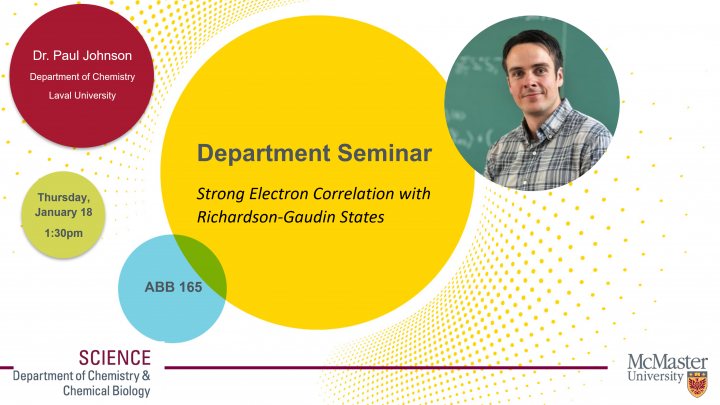Department Seminar: Dr. Paul Johnson
Jan 18, 2024
1:30PM to 2:20PM

Date/Time
Date(s) - 18/01/2024
1:30 pm - 2:20 pm
Title: Strong Electron Correlation with Richardson-Gaudin States
Date: Thursday January 18, 2024
Time: 1:30-2:20pm
Room: ABB 165
Host: Dr. Paul Ayers
Abstract:
Chemical behaviour is described by the electronic Schrödinger equation. We solve for the system’s energy and its wavefunction from which all its other properties may be computed. Accurate solutions can be obtained by brute strength at a cost that grows exponentially with the system size. A large portion of systems in chemistry are weakly correlated: they are qualitatively described by independent electrons. Established methods of quantum chemistry, in particular density functional theory and coupled-cluster theory, treat weakly correlated systems very well with a polynomial cost. It is routine to compute reaction energies and chemical properties for weakly correlated systems with a reasonable degree of certainty. For strongly correlated systems, in which the average behaviour is not independent electrons, the established methods either fail or become far too expensive to use. Strongly correlated systems are ubiquitous in chemistry and physics. They include, in particular, bond-breaking processes, reaction transition states, high Tc superconductors and molecular magnets.
For strongly-correlated molecular systems, we have shown that the eigenvectors of reduced Bardeen-Cooper-Schrieffer Hamiltonians, so-called Richardson-Gaudin (RG) states, are a much better starting point. They describe weakly-correlated pairs of electrons. They are tractable variationally and form a basis for the Hilbert space allowing for systematic improvement.
We will show for strongly correlated systems that a single RG state is a very good approximation to the wavefunction. Corrections for the remaining weak electronic correlation are obtainable with an approximate functional, or with a short CI expansion in RG states. Thus, the present development is an analogue of both Kohn-Sham DFT and correlated wavefunction theories based on Slater determinant references.
